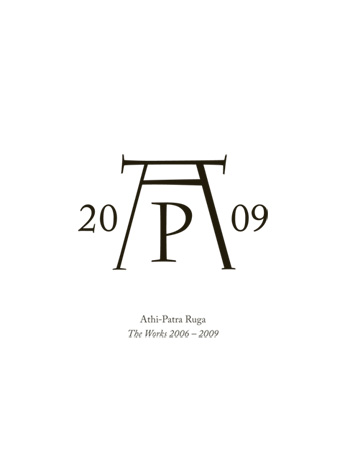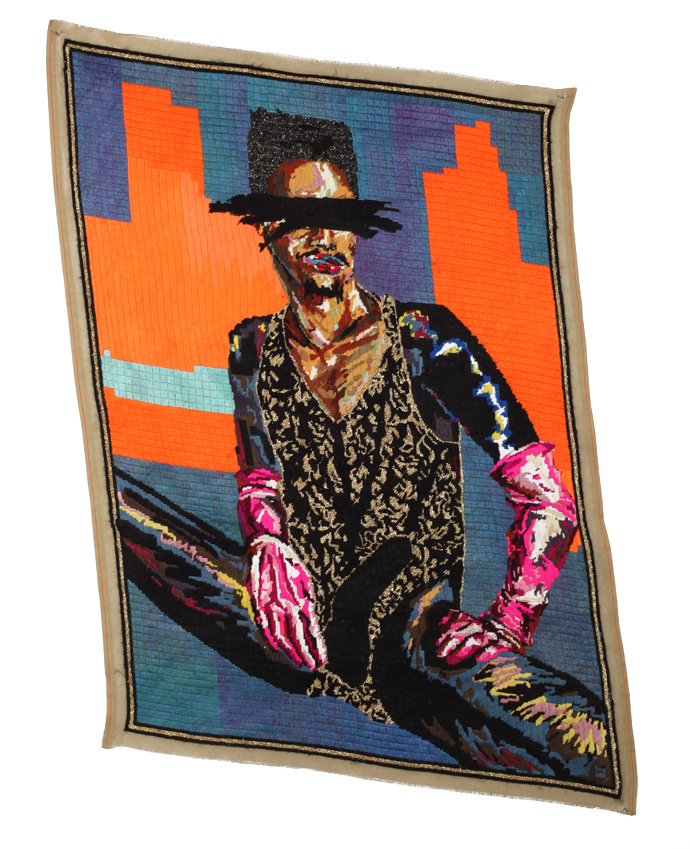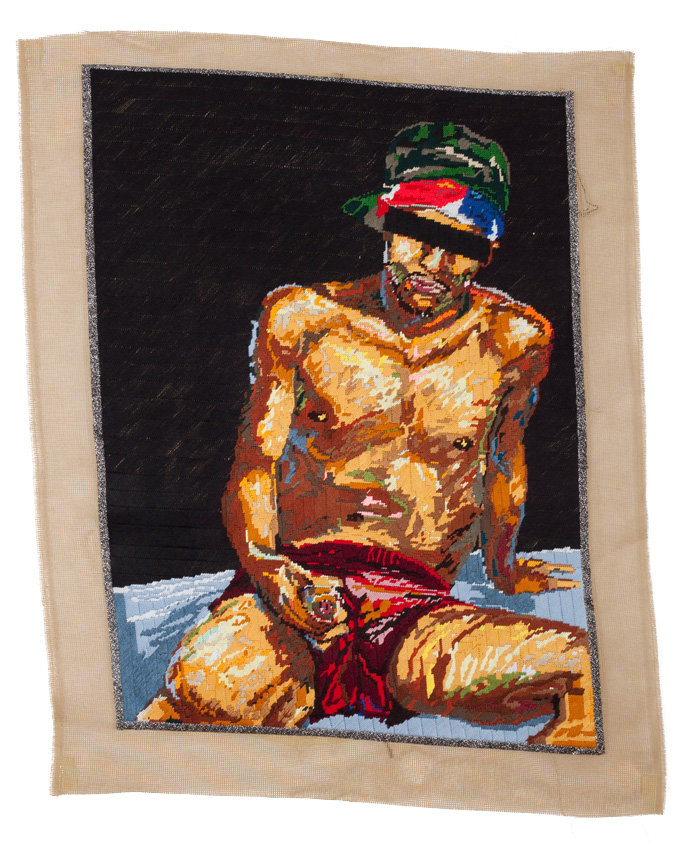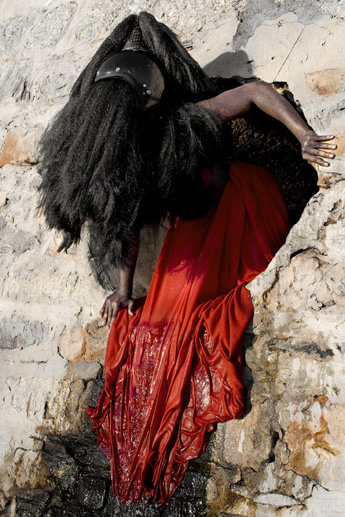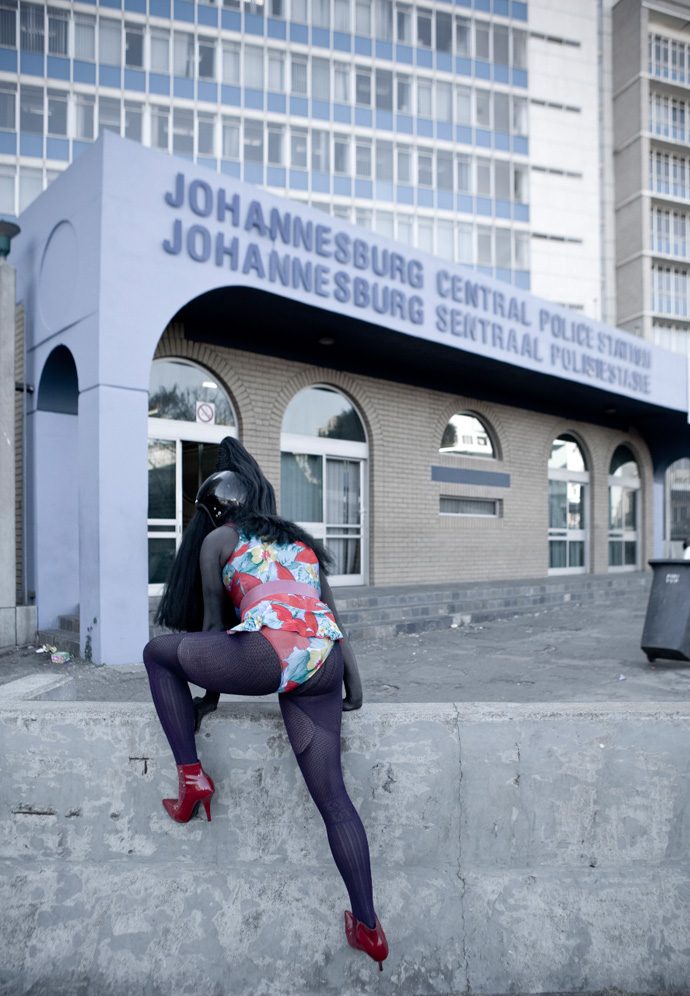ATHI-PATRA RUGA: tales of bugchasers, watussi faghags and the afro-womble
The ascension of young South African artist Athi-Patra Ruga came fast under radar of International attention.
His work, that is often characterized by a dislocated humor, is transcending the divides between fashion, performance and photography and interrogates the body in relation to society, ideology and politics, subverting the western ‘art library’ as he calls it.
The Stimuleye talks to charming Athi-Patra, who was recently featured in the Phaidon book ‘Younger Than Jesus’, a directory of the world’s best artists under the age of 33, about his work and influences.
Athi Patra Ruga’s intervention for the X-Homes Hillbrow project with the character of ILUWANE. Photography by Nadine Hutton
RENÉ HABERMACHER: Where are you right now?
ATHI-PATRA RUGA: I’m in my Cape Town studio editing my latest tapestry series and fighting my cats… simultaneously. [laughs] I’m big on cat competitions… my two Russian blues Azange and Shadofax will be taking part so we have been grooming them like crazy… with a few scratches to prove it… hehe.
You’ve just came back from a break – have you got an idea already on what to work on?
At the moment I will be spending the next year creating quietly an extensive body of work revolving around a series of portraits that I will be rendering in tapestry. I have been doing a lot of sittings with various people and doing preliminary sketches. I am editing those now to get started in the next month. I was thinking of titles to name this body or the final exhibition etc: What do you think of :…the do’s and dont’s of bodyworship [laughs]
I am very interested in the power-relations involved in portraiture… especially in response to the ethnographic history involved. I am always concerned with who or what element in the image takes more precedents/importance… the technique or the seater or the artists ego. That argument in my head leads to some lovely renderings.
Your work is known to straddle the divides between fashion, performance and many more disciplines. What is your ultimate goal?
Transcending all boundaries that have been put on who and what one should create.
Athi-Patra Ruga's monogram and portrait photographed by Ant Strack
The monogram you use ‘AP’, seems to be derived from Albrecht Dürer?
Nice spotting, yes Dürer is the reference. A big part of the work is appropriation and ultimately subverting the “western art library”. In this case I am always interested in this “I am the one and only”, self-centric way of creating or rather I am totally disturbed by it. The logo is for Athi-Patra Ruga and studios cc. The name of my company and studio. The “and studio” part alludes to the idea that collaboration forms a big part of my practice. I would like to continue with this point.
Does Athi-Patra mean anything specific?
No, it’s a brand like others. And a brand is the highest promise of good quality and superior concept.
It’s two nicknames of my birth name. I’ve been called those names all my life really. It’s as old as I can remember.
So where does the “evil little boy”, as you called yourself come from?
Well I don’t know… I embrace my evils and vices I suppose. As to where it comes from, let’s just say there are a lot of boys and girls think so… at some points I tend to believe it. [laughs]
I was born in a Bantustan, which is a puppet state created by the apartheid government, a dictatorship. In March 1984, on my 13th birthday, Biggie Smalls died. My mom was a midwife, my dad a sports journalist. My parents were gone for long stretches of time and I had to defend myself. It seemed natural, it was one big ball of trauma. I grew up in the townships and during the strikes and boycotts. Many kids [or rather young adults] used to brutalise us for going to suburban/private schools. I spent most of my time indoors as many kids could not cope with me: I was violent in a violent time. Both at home and outside, the country was going through a revolution.
Athi-Patra Ruga: "Idol Death Mask Series" 2009, Modeled Paper, Approx. 27cm x 23cm each Image courtesy of the artist and whatiftheworld gallery
How does your family perceive your work as an artist?
Amused. However one would expect, from many conversations, that they would have problems, but I grew up in a very art-sensitive home. They have been very supportive with the rising to actually making my own money. That investment is certainly paying back for them. Proud would be the one word.
It’s said we primarily derive our topics and reflections from childhood experiences- (I admit it sounds very freudian) do you feel the same? what do you remember having left an important mark in your consciousness?
There are so many. I think the ones that have filtered to my image-making a probably those that have been a wake up call as to realising my identity. For example the first moment I was ever called a Kaffir/Faggot/Hood-Rat. I came out at 12 year old. So I had to deal with it.
In a way, I also feel that this resistance to my identity validates me.
However, in my work I try to be graceful and answer or make sense as to why people can so label others with such vitriol. This leads me to one explanation, of which the history and the effects of popular image making become a little formula I use to understand and convey in turn healing these early memories we are speaking about.
When you left home- what did you go for?
I left home at 17. I had just graduated from a liberal arts highs school and moved to Johannesburg to study Haute Couture.
Tell me what is your flirt with fashion about?
I don’t flirt with fashion – I’ve seen what heroine did to my friends and yep…! I think it’s my addiction to the idea/s of perception and the result of that in relation to my life and art.
Fashion is like being part of a SAW Trilogy movie or something.
Don’t get me wrong I love my Raf and shit but I have my issues with it. I cannot play around or even fuck with anything that lacks a political backbone and is transient.
Left: Athi-Patra Ruga, "Castrato as [the] Revolution" 2010 Wool and tapestry thread on Tapestry Canvas, 80cm x 125cm
Right: Athi-Patra Ruga, Votive portrait (umthondo Wesizwe) 2009 Thread on tapestry canvas 74x 94cm. Images courtesy of the artist and whatiftheworld gallery
Is there a connection with your most recent work, the tapestries?
In 2005 after leaving Haute Couture school, I wanted a little hobby to keep that “petite main” discipline going on. It some how led to me picking up readymade tapestries, of which I then felt I could continue also my interventions by actually carrying these said interventions on the canvas – a DADA thing I always say, but it alludes to the point earlier of my obsession with how we receive and act upon imagery. Most of the time the images are very faux naive. However, by the time I am done re-owning them… they are totally different stories. I find that act to be triumphant and a fat middle finger to those ignorant image makers out there.
How much does the backdrop of South Africa form your identity and your work?
Well, to begin with I am Athi.
Then along the way we can add many a labels. South African being one of them. However as much as this is something I do not cling to so much in my work, I do not want to give the impression that the South African Dynamic is nothing I do not interrogate in my work. There is a rich mythology and language that is influenced by the mixes in languages and nuances in this country that lead to a visceral rendering in different design/art elements in my work. I would think it a sin to make or render my practice into a “Poster Boy for South Africa” Sometimes I tend to be very anti-South Africa, that’s part of it, I suppose.
The collective consciousness in the global sense is my concern , as I feel that I have been born into a world that already has so many issues that intermingle through colonialism/christianity/commerce. This hybrid of problems is not only a South African thing. It would be silly to think that MTV and the internet have not had a role to play in this continent and the african diaspora. I travel extensively and I feel that it is a big goal of mine to understand every culture today and to communicate to them. I shy away from art that separates me from the global collective experience by churning art that auto-exoticises me.
[…] If I would have to leave the country, I would like to move to Kinshasa. It’s indescribable!
The history of the place, the music, the culture of physical fitness, the sex, and how in a world that has nothing, people create the most optimistic environments for themselves. This is a place I consider a spiritual home for me, there is a newness in how a society can be resilient and form its own modes of beauty that absolutely blows my mind. And I would love to be part of this newness.
Hypothetically the move would be like many that I have made, simply a new chapter with new concerns and struggles and obviously this will translate in my work as I am a firm believer in the relationship between acting and art making.
Athi Patra Ruga: "Untitled" (X Homes Hillbrow). Photography by Nadine Hutton
Can you tell me more on who is the character of AFRO-WOMBLE and the story behind?
The Afro-Womble character came after my seminal character of Miss Congo. In 2007 I was invited to do a show in Switzerland after a three month residency. I had created an outfit made of a loooot of afro wigs, a poetic stab at the performance-driven christmas parties in lilly-white corporate settings. And also I was going through a phase of translating brutalist / Le Corbusier manifestos into clothes as an exercise.
So the story begins when I was coming out of a Bern club and I see this poster of two white sheep kicking a black sheep of the Swiss Confederation flag, rendered in very cutesy manner that would make Murakami weep. On being told what it was all about and then after just freaking out about its xenophobic connotations, I decided to do a series of performances on a fast-melting glacier, a sheep farm in Lucerne, and an intervention in Zurich during election Day. The way in which the material and many memories clash, and the results that come out is a leading thing in unraveling the work.
I enjoyed Switzerland… I was in Bern with a very cool circle of friends who were all expats from Europe Africa and America. I took speed for the first time there.
How did the Swiss react to your street performance?
It’s interesting that they could identify the schwarze schafe [sic]. The immigrants felt I was poking fun at something they were in the thick of. That made me want to take responsibility for their pain… however I am merely an artist, not an activist you see. I seek engagement, I solicite engagement – Not a confrontation, that gets us nowhere.

Top Left: Swiss People's Party (SVP) "Create safety" poster for the abduction of criminal foreigners in Switzerland Following: Athi-Patra Ruga's reaction with the character of Afrowomble: "Even I Exist in Embo: Jaundiced Tales of Counterpenetration", 2008. Photography by Oliver Neubert.
How you felt being in Switzerland?
I felt unchallenged…
In the “international” art circuit African artists are comparably underrepresented. So are women. What are your thoughts on current racial and gender segregation issues in the art world?
They [THE SO CALLED INTERNATIONAL] do not even enter my headspace. I feel that would be pandering to others codes of acceptance. Integrity and a good work ethic gets you to the places you wanna be at. And also I feel that us as women/gays/blacks/non-christians/lepers/tax evaders etc. have the responsibilities of owning our destiny. That is very important to me.
In your performances you use your own body as a tool- part of this is altering, dislocating and manipulating your physique and with this challenge the perception of classic gender roles.
For me it is a way of returning to a sense of embodiment, simply. I cannot comment on fashion’s apolitical and transient nature without physically mirroring and in turn subverting it’s patriarchal elements of shape shifting and engineering a woman’s body. This leads to a certain amount of disembodiment, non?
This translates in my performances in the sense that when I perform, my preparation is to hire a personal trainer to mould my body. Like the skinny fag designers do – with me being in charge of course. For MISS CONGO I could fit into a size 34, for BEIRUTH too. Later on when I decide to kill Beiruth [for the print series…”THE DEATH OF BEIRUTH”] I decided to gain 20 kg’s. Now with the latest character Ilulwane, I want to have this amazon-like musculature, all in the name of conveying ides around the body-politik.
Athi-Patra Ruga: "The Death of Beiruth" #1 & #2, 2009, Lightjet Print, 74 x 107 cm, Edition of 5 + 2AP Images courtesy of the artist and whatiftheworld gallery
One of your recent exhibit is called ‘…OF BUGCHASERS AND WATUSSI FAGHAGS’, I love this title! What’s the story behind it?
‘…OF BUGCHASERS AND WATUSSI FAGHAGS’ was the first solo exhibition of Athi-Patra Ruga’s to be held in Johannesburg. The exhibition revolves around the principal character of the “bugchaser”, Beiruth, and his ‘tales of counter-penetration’, realised through craft-mediations and performances undertaken in various urban centers around South Africa and abroad.
This body of work is an interrogation of my interest in the history of image-making, and of displacement – both of people and images. The title of the show is double-edged: it refers to the sexual practice of ‘bug-chasing’ (the act of contracting the H.I. virus intentionally) – with it’s seemingly altruistic motivation; while also referring to the history of the ‘Watussi’, a colonial mis-pronouncement of the Tutsi people of the Burundi-Ruanda nation. The Watussi myth is further explored in the “Pixilated Arcadia” series of tapestries, referencing paintings done by Irma Stern during her 1943 and 1946 expeditions to central Africa depicting the “Watussi”. Stern’s works are re-narrated through irreverent subversion, with the aim of focusing attention on the implicit ethnographic and propagandistic undertones of the work. The “Watussi women” meditations find their retort in the “… WATUSSI MONEYSHOT” (2008) tapestry – a parody on the historical and the contemporary hoochie-mamma…
Athi-Patra Ruga: "the naivety of Beiruth", 2008, lightjet print on fuji crystal archive paper, 40 x 60cm. Photo by Chris Saunders. Images courtesy of the artist and whatiftheworld gallery
There is this work I did with BEIRUTH….a quick background:
In 2008 , a young lady was physically beaten up in Johannesburg for wearing a mini-skirt[ yes]. it sparked an outcry from us more enlightened people…it is the event that gave rise to Beiruth. as you see Beiruth is this hyper feminine creature who is what people probably found threatening with that young girls honing of her “sexualness”. It’s has a lot to do with putting people civilisation to the test by means of mirroring it…reflecting it.
Beiruth’s name is derived from a pun around the middle-eastern city of Beirut and Ruth, one of the two books in the christian bible authored by a woman…or the only two that were allowed in the bible. – a play on the theme of Orientalism; but more importantly it is the illusive figure that qualifies the autonomous body against that of the sovereign state. The BEIRUTH debut is in a video work title: “…after he left” (2008), the BEIRUTH is documented undertaking various journeys: catching a taxi to the Cape Town township of Atlantis, a place that is a far cry from its legendary namesake; Beiruth seeking a sensual ideal in the form of the increasingly-popular evangelical churches. The video is accompanied by a series of performative stills “…the naivety of Beiruth” (2008), which documents Beiruth’s interactions with various spaces of the inner-city, including Johannesburg Central Police Station (formerly John Voster Square- notorious for deaths in detention during the apartheid).
South African society still suffers from a lot of fractions….
South Africa was built and was sustained for 300 plus years on separation. It’s all we know. The other validates you as a body not you validate yourself…. I believe the whole world has that syndrome.
South Africa is too young a country. The population is starting to engage with race and gender issues now in relation to reconciliation maybe.
Is it that wearing a “miniskirt” or being openly gay becomes a statement, more than just taking your freedom…
….and if it’s a simple statement, you must be neutralised. Unless you fight tooth and nail to retain it. That is the legacy of this country on my generation: WE FIGHT. Coz freedom is all we know….and would give up a lot to retain that personal freedom.
All you have to do is check out skattie. That is the little group we live and express our selves in… against maybe 70 percent of the country. And we fight to retain it. we are having crazy fun down here!
Hope i’ll have the chance sometime to check it out myself!
From your lips to god’s ears….
Athi Patra Ruga: "Deadboyz Auto Exotica Series" 1, 74 x 107 cm, Edition of 5 +2 AP, Photographer: Oliver Kruger Image courtesy of the artist
What is up next?
I have just come out of a crazy year of gallery exhibitions which started with one in London’s FRED LTD. ,and include a solo here in Cape Town [“Teeth are the only bones that show.”] , a series of performances and now the solo that happened at The VOLTA NY Fair in March. I have also been selected to present a work at the PERFORMA biennale in New York so I shall be travelling that side a lot for pre production for the final performance to take place in November. Performance will take the fore this year clearly as i find that it is usually the basic canon and starting for projects in my other media.
I’m very excited about the PERFORMA piece and how it is developing right now:
Most of the performance works that I make revolve around the interventionist execution, where I am firstly influence by a space along with its myths and history , for this work I will finally be doing what i call an “opera sans mots” inspired by the visual works of my long time heroes David Worjnarowicz and Alvin Baltrop with the latter being the icon of the work. Manhattans West Side Piers forms the backdrop of the space.
Athi-Patra Ruga is represented by the whatiftheworld gallery
2 Comments
Pingbacks
-
[…] now hand you Athi-Patra Ruga talking about Himself, where he has been, Art and the low down on Ilulwane, his soon to be […]
-
[…] create”, as he points out in an interview with photographer René Habermacher, which was published on Habermacher’s blog The Stimuleye last year and which I really recommend. Germans and French people also find a short video portrait […]
[…] now hand you Athi-Patra Ruga talking about Himself, where he has been, Art and the low down on Ilulwane, his soon to be […]
[…] create”, as he points out in an interview with photographer René Habermacher, which was published on Habermacher’s blog The Stimuleye last year and which I really recommend. Germans and French people also find a short video portrait […]
